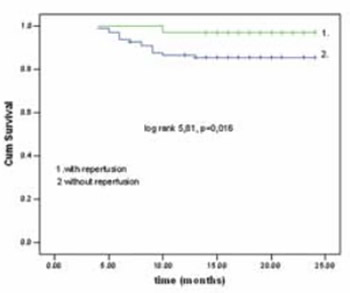Survival Benefit of the Late Percutaneous Coronary Intervention in the Patients after Acute Myocardial Infarction Who Are Or Who Are Not Treated with Thrombolysis
DOI:
https://doi.org/10.17305/bjbms.2009.2857Keywords:
Thrombolysis, prognosisAbstract
The impact of late percutaneous coronary intervention (PCI) in the patients after acute myocardial infarction (AMI) on long term mortality remains to be established. At currently, thrombolysis is accepted as standard therapy when PCI is not immediately available. However, PCI is often performed in stable patients with AMI who are/are not received thrombolysis .
We performed the trial that enrolled myocardial infarction patients treated with thrombolysis, late PCI and medically to assess the potential benefits of delayed PCI.
We follow up 164 consecutive patients after AMI one year. The patients are divided in two groups; first group-66 patients who received reperfusion (37 patients received only thrombolysis, 10 patients received thrombolysis and PCI 7-9 days after thrombolysis and 19 patients underwent only PCI after 7-9 days) and second group-98 patients medically treated. One year mortality was 3% in the reperfusion group (2/66) and 14,3% in the medical group (14/98) (p=0,016). There were not significant differences between groups about other end points-reinfarctus, coronary artery bypass surgery and PCI performed later after discharge. The major predictors of one year mortality were ages (p<0,001) and ejection fraction (p=0,003). Also, therapy with beta-blockers (p=0,002), statins (p=0,001) and ACE-inhibitors (p=0,024) was associated with better survival.
Delayed PCI performed 7-9 days after AMI in the patients who underwent thrombolysis or those did not improves outcome at long-term follow-up
Citations
Downloads

Downloads
Published
Issue
Section
Categories
How to Cite
Accepted 2017-12-19
Published 2009-02-20









